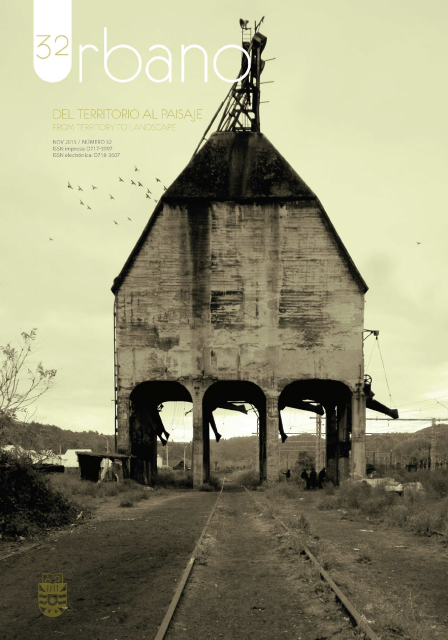Towards infrastructural architecture and urban planning
Keywords:
infrastructure, architecture, urban planning, systems, JapanAbstract
This article conceptually explores notions of architecture, urban planning and infrastructure in order to discover structures that are able to integrate these three dimensions. Within this framework, and based on Stan Allen ́s text Urbanismo Infraestructural (Infrastructural Urban Planning), three categories of study are established. First, Flow Systems, reviews concepts and case studies from the perspective of flow systems, movement networks and architectures that use them as project material. Field Conditions, studies two cases, Berlin Haupstadt and PotteriesThinkbelt, as settings for a new way to build the place itself, supported by infrastructural systems, to generate solutions that leave the system open to new developments and possibilities. Lastly, Infrastructural Architecture and Urban Planning takes as a case study Japanese stations and associated malls, as they are settings where certain conditions are concentrated and expand, thus creating new types and new spatial and programmatic possibilities.
Downloads
References
Bibliografía
Allen, Stan: El urbanismo de las infraestructuras: siete proposiciones. En: Circo (1998), Nr. 59. Disponible en <http://www.mansilla-tunon.com/circo/epoca3/pdf/1998_059.pdf> [Consulta: 12 agosto 2015]
Balmond, Cecil; Smith, Jannuzzi: Informal. Munich : Prestel-Verlag, 2002 — ISBN 3791324004
Gargiani, Roberto: Rem Koolhaas/OMA : the construction of merveilles. Essays in . ed. Lausanne : EPFL Press, 2008 — ISBN 9782940222223
Guridi Garcia, Rafael; Tartás Ruiz, Cristina: Infrastructures as Public Space Modelers: The Case of Hauptstadt Berlin in the Proposals of Hans Scharoun and Alison & Peter Smithson. En: Eurao´12. Oporto, 2012 [Consulta: 21 abril 2015]
Hidetoshi, Ohno: Tokyo 2050 fibercity. En: Yoshida, N. (ed.) JA The Japan Architect. Tokyo, Shinkenchu-Sha Co. (2006), Nr. 63 ISBN 478690192x
Japan Statistics Bureau: Japan Statistical YearBook 2011. Tokyo : Ministery of Internal Affairs, 2011
JR-East Co.: East Japan Railway Co. URL http://www.jreast.co.jp/e/data/index.html. — Corporate Data
Koolhaas, Rem ; Obrist, Hans-Ulrich ; Ota, Kayoko: Project Japan: Metabolism Talks. 1st ed. ed. Colonia: Taschen, 2011 — ISBN 3836525089
Koolhaas, Rem; Mau, Bruce; Werlemann, Hans: S, M, L, XL. 2a ed. ed. New York: Monacelli Press, 2002 — ISBN 9781885254863
Kuroda, Junzo y Kaijima, Momoyo: Made in Tokyo. Tokyo : Kajima Institute Publishing, 2001 — ISBN 978-4306044210
Kwinter, Sanford: Requiem: For the City at the End of the Millennium. 1a. ed. Barcelona : Actar, 2010 — ISBN 978-8492861200
Matsushita, Kiwa. Depato. En Chung, C. J; Inaba, J; Koolhaas, R; Leong, S.T. School of Design, Harvard University. Graduate School: Harvard Design School Guide to Shopping, Project on the city : Taschen, 2002 — ISBN 9783822860472
RAE: Diccionario de la Real Academia de la Lengua Española. URL http://lema.rae.es
Risselada, Max; van den Heuvel, Dirk; Bosman, Jos; et al.: Team 10 1953 - 1981 In Search of A Utopia of the Present. Rotterdam : NAi Publishers, 2005 — ISBN 9056624717
Sacchi, Livio: Tokyo-to : architettura e città. Milano : Skira, 2004 — ISBN 8884919894
Salvadó, Ton: ¿Por qué la Freie Universität Berlin debería ser un mat-building? URL http://revista.dpa.upc.edu/ARCHIVO/DPA2728/dpa27.html. — DPA Documents de Projectes d´Arquitectura
Tsukamoto, Yoshiharu; Kaijima, Momoyo, Studio Atelier Bow Wow: Bow Wow From Post City Bubble. 1st ed. ed. Tokyo : Inax Publishing, 2006 ISBN 872751337C0052
Downloads
Published
How to Cite
Issue
Section
License
The content of articles which are published in each edition of Habitat Sustentable, is the exclusive responsibility of the author(s) and does not necessarily represent the thinking or compromise the opinion of University of the Bio-Bio.
The author(s) conserve their copyright and guarantee to the journal, the right of first publication of their work. This will simultaneously be subject to the Creative Commons Recognition License CC BY-SA, which allows others to share-copy, transform or create new materials from this work for non-commercial purposes, as long as they recognize authorship and the first publication in this journal, and its new creations are under a license with the same terms.![]()























